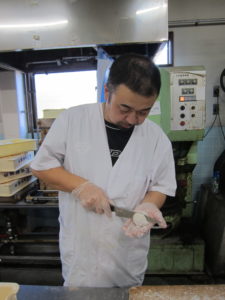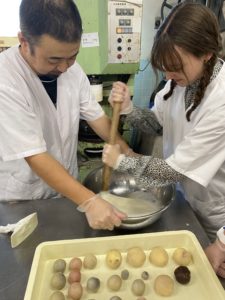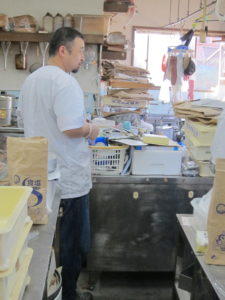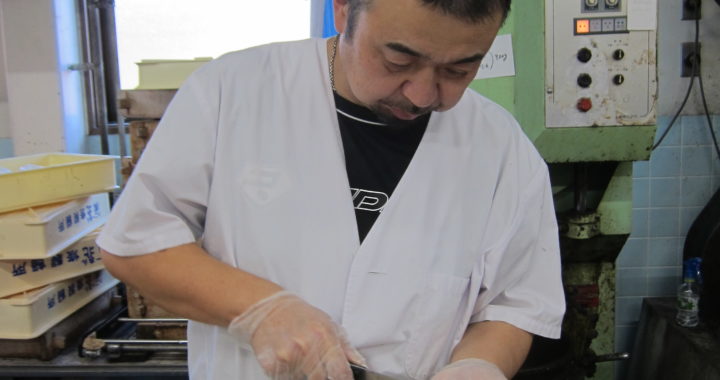Japanese sweets and tea are often served together. The connection between Obubu Tea Farms and Midoriya’s Toshimasa-san also runs deep. He often brings us delicious mochi to eat while we drink tea together. That’s why our intern’s have given him the endearing nickname “Mochiman”! Recently, we were able to speak with him about tea, sweets, and the future of Wazuka.
—Where are you from?
I’m from Wazuka.
—What do you think the attraction of Wazuka is?
The delicious tea and beautiful scenery.
—When did you start liking wagashi (Japanese sweets)?
Hm, back in middle school, I thought wagashi was the kind of thing old people ate. It wasn’t too sweet, but then around high school, I started eating daifuku mochi (rice cakes filled with red bean paste) and dorayaki (red bean paste pancakes).

—When you’re making good wagashi, what is an important point to consider?
I always am careful to use good ingredients and to treat them with respect.
—Wagashi and tea go so well together. As you were making wagashi, have you ever considered pairing it with a particular tea?
Oh, I think about this a lot! For example, when I’m making dorayaki, I think hojicha would go well. Sometimes, when I’m drinking tea, I imagine what wagashi I should make.
—Oh, really? So, you’ll be drinking tea and think “maybe this wagashi would be good”?
Yes, I do, and also…how can I say it right? For example, if I’m making daifuku mochi, I’ll think about “which tea would be good with this?”. As I’m making wagashi, I often consider that, if I make it in a particular way, it will pair well with tea.
—So, it’s maybe the same question in reverse, but you can also make wagashi out of tea-based ingredients. For example, there’s matcha and hojicha powder. What is your favorite tea ingredient?
It’s matcha.
—Matcha?
It’s great because you can use it in anything!
—The wagashi industry is changing quickly. What kinds of changes do you think are coming? What ought to be preserved?
Indeed, there’s a change occurring. Sweets that are mixed with Western-style desserts are coming out…
—Like with whipped cream, etc.?
Yes, for example, daifuku mochi with strawberry and whipped cream. It’s changing in that way.
Also, taking a castella cake (a Portuguese cake brought to Japan in the 16th-century) and making a sandwich with anko (red bean paste)…all kinds of new sweets are coming out that never existed in the past!
—That sounds like a possibility, doesn’t it? Being able to create new kinds of sweets…
Yes, that type of change is occurring. So, what do I think should be preserved? I think that it’s about preserving the base of wagashi. We can add or mix as we want, but we should take care first of the basics of wagashi.
—So, wagashi has a basic core?
Yes.
—What is your favorite tea?
Hm, oh, it’s hojicha.
—Hojicha? Why do you think so?
I’ve been drinking it for such a long time.
—Oh, really?
Ever since I was super small. Wazuka’s people don’t have a custom of drinking water…everyone’s water is actually tea!
—Haha, then hojicha would go well with dorayaki, right?
Oh, yes!

—What do you think about Wazuka’s future?
Hm, regarding tea, I think the number of people thinking about tea in the right way is actually growing. So, the amount of good tea that you can sell is going to increase. But, of course, a supply is needed to meet that demand.
And, maybe even more important is that tourists come back. Before coronavirus, visitors came from all over the world, but they still haven’t quite returned to Wazuka yet. If you look at Nara or Osaka, it seems like they’re starting to be able to come back, so I think that these people will be able to come back to Wazuka as well.
—Well, that might happen this month, no? (Shortly after this interview, Japan’s government loosened its coronavirus-era border controls.)
—True.
—Do you have something you’d like to share with our readers in Japan and abroad?
Please come to Wazuka at least once.
—Yes, please come to Wazuka.
Indeed, I want you to come see this beautiful scenery, to drink real tea, to eat wagashi that can’t be eaten abroad.
—What type of wagashi?
Daifuku mochi and so on. First, you should try anko. Outside of Japan, people don’t often eat red bean paste, so you should try that first.
—Thanks so much for sharing your time today.
Thank you very much.


